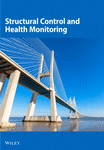Robust active control of hysteretic base-isolated structures: Application to the benchmark smart base-isolated building
Abstract
The main objective of applying robust active control to base-isolated structures is to protect them in the event of an earthquake. Taking advantage of the discontinuous control theory, a static discontinuous active bang-bang type control is developed using only the measure of the velocity at the base as a feedback. Moreover, due to that in many engineering applications, accelerometers are the only devices that provide information available for feedback; our velocity feedback controller could be easily extended by using just acceleration information through a filter. The main contributions of this paper are the development and application of (a) a static velocity feedback controller design and (b) a dynamic acceleration feedback controller design to a benchmark problem, which is recognized as a state-of-the-art model for numerical experiments of seismic control attenuation. The performance indices show that the proposed controller behaves satisfactorily and with a reasonable control effort. Copyright © 2008 John Wiley & Sons, Ltd.




